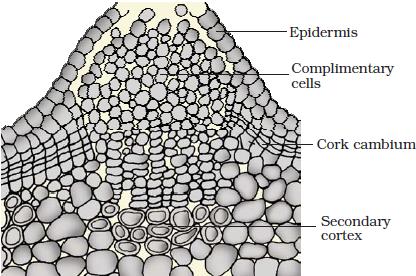The vascular cambium keeps dividing and helps in increasing the girth of the plant stem. The cortex and epidermial layers will be broken and disappear gradually while new layers meant for protection are developed. Eventually, a meristematic tissue or layer develops known as cork cambium or phellogen in the cortical region. Phellogen is made of rectangular cells that are narrow and possess thin walls. Cells divide on either side of the phellogen. The cells that are cut towards outside are called as cork or phellem. The cells that are separated into inwards constitute phelloderm or secondary cortex. The cell walls of the cells in the cork region are deposited with suberin and hence they are impermeable to water. The three layers called phellogen, phellem and phelloderm are together known as periderm.
As the activity of the phellogen cells increase, much pressure builds up on the cells that are outwards to the phellogen. Hence, these layers ultimately do not survive. The tissues that are present towards the outer side of the phellogen or vascular cambium are collectively called as Bark. The Bark also includes secondary phloem. There are various tissues that come under Bark like periderm, secondary phloem and so on. If the bark is formed in the early part of the season then it is called as soft bark or early bark. If it is formed towards the end of the season then it is called as late bark or hard bark.
At some regions of the trunk, there are some phellogen cells that give rise to parenchymatous cells instead of giving out cork cells. The epidermis is ruptured by the parenchymatous cells to form the lens shaped openings known as lenticels. These lenticels help in the exchange of gases between the outside and inside of the stem.



No comments:
Post a Comment